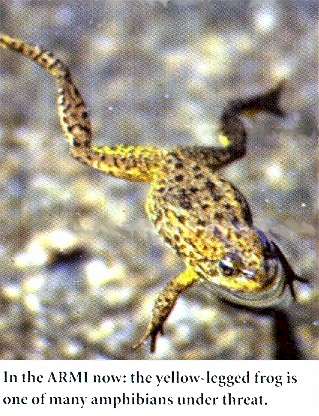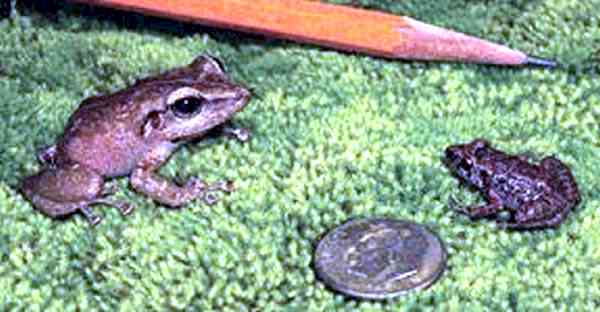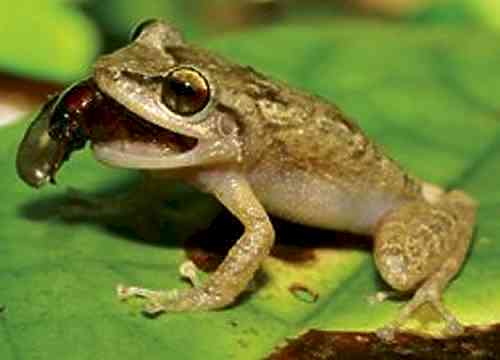Proverbial Canaries
Frog-March Is No JokeWhat's green and dangerous? A frog with a hand-grenade What do you have if you're holding two green balls? Kermit's full attention.
Paris - Since the "Rosbifs" (as the French call the British) are having trouble with roast beef, it seems only fair that France should be overrun by frogs. No ordinary frogs. A plague of giant Californian bullfrogs is threatening to disrupt the ecology of south-western France. The aggressive and voracious bullfrog (Rana catesbeiana), introduced illegally 20 years ago, can weigh four pounds. It consumes frogs, fish, lizards and even small birds. Since the frogs were released, as a joke, on a private pond near Libourne in the early 80s, they have colonised ponds, lakes, marshes and gravel pits all over the Gironde. "This is a real threat to the freshwater environment," said Christophe Coc of the environmental group Cistude. "We must do something before it is too late. The survival of several indigenous species depends upon it." Mr Coc's association is organising a campaign of eradication. But destroying the frogs is not easy. The Gironde fisheries protection association used electric poles to attack a pond full of bullfrogs two years ago. The frogs fought back. "We battled with them for two hours and killed just one so we gave up," Michel Vigneaud said. Mr Coc is urging members of his group and sympathisers to kill the frogs at the tadpole stage. But they are urged to take care. Volunteers exterminated all the tadpoles in one pond, then found they belonged to a rare species of indigenous frog. - The Independent Source: The Evening Post Tuesday 3 April 2001
Meanwhile, some places have a problem with too few frogs... Amphibians Come Under Studyby Rex Dalton, San Diego
The national Amphibian Research and Monitoring Initiative (ARMI) has been set up by the US Department of the Interior with $5 million to study why frogs, salamanders and toads are in such trouble. An additional $2 million is being sought for next year's budget. Initially, ARMI will examine amphibians on the nation's extensive federal lands, but officials hope to expand the programme to other habitats. Coordinated by the US Geological Survey (USGS), the scheme was created after scientists captured the attention of Interior Secretary Bruce Babbitt with reports of amphibian distress. "This is now a front-burner issue," says James Hanken, herpetology curator at Harvard University's Museum of Comparative Zoology. "This is not just a plan; things are happening." Hanken was among a group of scientists who met early last month in West Virginia to design ARMI. Officials from various federal agencies, including the National Science Foundation, the National Institutes of Health and the Environmental Protection Agency, also took part. Under ARMI, the nation has been divided into seven regions of particular amphibian characteristics, says Daniel James, a USGS wildlife biologist who is coordinating the programme. Government agencies had strong herpetological staff in four regions, but not in the Mississippi River Valley or the Northeast, so the department is seeking new scientists to augment its resources. Initially, researchers will survey many sites in large sections of National Parks, National Wildlife Refuges and Bureau of Land Management areas. They will then focus on a few species at a limited number of locations in an attempt to determine what ecological factors are contributing to the declines and deformities. The ARMI effort is taking place at a time when scientists around the world are seeking better understanding of the broad declines taking place in global amphibian populations. Pollutants, increased amphibian susceptibility to disease, and decreases in the ozone layer are all being considered. An international group of scientists, the Declining Amphibian Populations Task Force, has played a major role in spurring amphibian research. ARMI is to become the permanent home of an amphibian atlas that is now being developed, officials said. In addition, federal officials have hired an amphibian pathologist at the National WIldlife Health Center in Madison, Wisconsin, to focus on the role of disease. ARMI also complements an on-going three-year amphibian study bythe NSF,which is already providing $3 million to 13 universities to study the causes of species declines. Source: Nature Vol 405 1 June 2000
Hawaii's Hated Frogs
Tiny Immigrants: adult coqui (left) and greenhouse frog (right) may be small, by Janet Raloff Puerto Rico's beloved mascot is a miniature tree frog named for its distinctive call: ko-KEE. All night long, choirs of love-starved males serenade would-be mates, who respond with quiet guttural chuckles. "To me, it's pleasant — just like birds singing," says Bryan Brunner, a University of Puerto Rico plant breeder in Mayaguez. "Here, everybody loves the coquies." And legend has it, he says, that coquies — native only to Puerto Rico — die of sadness when removed from their island. Hawaiians are lamenting that that fable isn't true. In the mid-1980s, potted plants from the Caribbean began arriving in Honolulu carrying frogs. Some were 5-centimetre-long coquies (Eleutherodactylus coqui), and others, a quieter and even tinier cousin, the greenhouse frog (Eleutherodactylus planirostris). These stowaways reveled in their new setting: a largely amphibian-free land with a bountiful smorgasbord of insects, tiny spiders, mites, and other delectables — and no snakes, tarantulas, or other natural predators. By the end of 1998, seven populations of coquies had established themselves on the Big Island of Hawaii, recalls Earl Campbell of the Fish and Wildlife Service (FWS) in Honolulu. And the number has rocketed. "We now have over 400 populations on the Big Island," reports Campbell, the FWS Pacific Basin coordinator for invasive-species issues. He also notes a few coqui outposts on Maui, Kauai, and Oahu. Local wildlife-protection officials have no trouble recognising new coqui populations. On the Big Island, public officials receive about 10 complaints a day from homeowners who, unlike Puerto Rican residents, get fed up with the racket, notes Tim J Ohashi of the Department of Agriculture's Wildlife Services Branch in Honolulu. A backyard full of the frogs can reach 70 to 90 decibels — the volume of moderate-to-heavy street traffic or the din in neighbourhoods along aircraft takeoff and landing corridors. Indeed, 75 decibels is the maximum sound volume that people can encounter at work throughout their careers without risking hearing loss. Hawaiians aren't used to such nighttime noise. "Because we don't have lots of calling insects, if you go to where the frogs aren't at night, it's dead quiet," observes herpetologist William J Mautz of the University of Hawaii at Hilo. "Then enter an area with a big infestation, and you hit this wall of sound." But it's not only the noise that has federal officials up in arms. The proliferating coqui and greenhouse frog populations on islands that evolved in the absence of amphibians threaten to overwhelm native ecosystems. That's why USDA has teamed up with the State of Hawaii and FWS to control — and, if possible, eradicate — the tiny hoppers. The scientists are developing tools, including caffeinated sprays and scalding showers, for holding back what they see as an advancing plague of frogs. For the many frogs and toads that spend their youths as tadpoles, early survival and development depend on access to water in which they can swim and feed. But for members of Eleutherodactylus, the world's largest genus of vertebrates, young emerge from the egg or from Mom as tiny, fully formed frogs. This opens up a broader range of habitats than is available to tadpoles. Water-soaked moss decorating a potted plant will do, as will the humid packaging around plants, or a spoonful of water cupped in the leaf of an ornamental bromeliad. Eggs, which coquies and greenhouse frogs lay on the soil, are hard to detect. Normally, male coquies guard their eggs for 2 to 3 weeks — not to fend off predators so much as to keep them moist, explains ecologist Larry Woolbright of Siena College in Loudonville, New York. Like a sponge, Dad's underbelly efficiently absorbs water and then releases it onto the eggs. But fatherless eggs could survive transit to Hawaii if they're attached to damp plant material. At hatching, baby coquies are green and only 5 millimetres long, about the size of a rice grain. Because they're nocturnal and don't begin bellowing their telltale serenades until they're about a year old, the youngsters tend to remain undetected, Woolbright says. The frogs' catholic tastes facilitate their integration into the Hawaiian environment. After sleeping under leaf litter all day, the tiny amphibians come out after dark to dine. Some stay near the ground, while others ascend into a tree's canopy. Then they sit patiently and await the arrival of the evening's entrees — insects or any other small creature that crawls within pouncing range.
Gotcha! Fairly indiscriminate diners, coquies will eat almost anything, like this bug, that enters their range. Hawaii's other Caribbean intruders, the greenhouse frogs, also concern scientists. So far, they've conducted relatively few studies of those quiet immigrants, which have proved difficult to find and count. Though coquies invaded Florida roughly a century ago, they haven't spread far there, Campbell notes, probably because they had plenty of competitors for food and shelter. But in Hawaii, he observes, "we don't have as many creatures as do ecosystems on the mainland, so we still have a lot of what people might term open niches." When the coquies and greenhouse frogs arrived, they set claim to one such niche. During mating season — which can run year round, depending on the climate — crooning males from ground to treetops produce a three-dimensional fog of sound. To drown it out at bedtime, many Hawaiians run air conditioners as a source of white noise. Others don earplugs. It's gotten so bad, Ohashi notes, that realtors have been forced to disclose the presence of coquies on listed properties, much as they would evidence of termites, water damage, or structural flaws. But of even bigger concern to USDA and Hawaii's Department of Agriculture is the frogs' economic threat to Hawaiian plant growers, notes Ohashi's colleague Will Pitt at USDA's Wildlife Services research center in Hilo. Sales of orchids and other tropical plants amount to a huge export industry. Buyers on the Hawaiian islands that are still free of coquies and greenhouse frogs are now rejecting some potted plants grown on the Big Island. It may not be long, Pitt speculates, before the frog scare affects foreign trade or plant shipments to the US mainland. Any impact on Hawaii's $80-million-per-year cut-flower-export industry would be especially troublesome. Rather than simply imposing a quarantine on plants in frog-infested areas of Hawaii, Pitt says, government agencies want to offer growers tools for coping with the problem. The proposed arsenal is remarkably low-tech. "We started, about 2 years ago, looking at trapping — hand captures — but it was not at all effective," says Pitt. So, Campbell, who was then with USDA, began screening off-the-shelf agents that might poison the frogs without harming their environment. "I started by looking at insecticides for use on ornamentals, probably 20 to 25 compounds," he says. None killed frogs at permitted application rates. Then Campbell heard that acetaminophen — the active ingredient in Tylenol — works as a poison to control the invasive brown tree snake on Guam. He redirected his attention to over-the-counter drugs and food additives. Again, the results were abysmal — until he tested a popular formulation for staying awake that contains caffeine. In Campbell's lab, coqui and greenhouse frogs died quickly after being sprayed with a 2%-caffeine solution (a far higher concentration of caffeine than coffee has). Because caffeine has never been federally approved as a pesticide, the State of Hawaii had to petition the Environmental Protection Agency for permission to experiment outdoors with the antifrog stimulant. The agency granted the state permission to try it as an experimental pesticide spray for 1 year. Pitt says that tests on small plots of infested greenery proved that the spray is indeed "an effective frogicide, if you will." Best of all, he says, caffeine exhibited "very few impacts on other, nontarget organisms." For instance, insect populations in sprayed plots declined a bit, but within a week had returned to normal. The tests turned up another potential benefit. Garden slugs, the bane of the orchid industry, rose to the surface of treated soils and died. In September, the temporary EPA permission for testing expired. USDA has now applied for a 3-year extension to conduct further research that might eventually lead to caffeine's federal approval as a frog-control agent. "But we don't want to limit ourselves to one tool," Pitt says, so his laboratory has continued testing other unusual candidate frogicides. It recently uncovered one that's so safe a food product that EPA doesn't regulate it: it's citric acid, the primary constituent of lemon juice. Preliminary tests, begun in August, used a citric-acid formulation roughly comparable to double-strength lemon juice. The spray isn't quite as potent as caffeine for killing frogs. Nevertheless, early data on citric acid "look very promising," Pitt says, "and we see very little impact on plants." In July, the Honolulu Star Bulletin reported that the Hawaii Department of Agriculture had found that hydrated lime, the powder used to reduce the acidity of soil, also kills frogs. Ohashi confirms this, but he points out that hydrated lime couldn't legally be used against frogs unless it were to receive federal approval as a pesticide. And that's unlikely, he adds. Manufacturers don't view as worthwhile the prospect of carrying out the necessary safety and efficacy testing, he explains, "because they make enough money selling it for its currently labeled use." Pitt says that plant growers might also resist lime because it can leave a white residue on treated plants. "If you're an orchid grower selling $200 or $300 plants, a little leaf spotting may not be acceptable," he says. Finally, several research centers are investigating an experimental nursery technique to prevent the spread of frogs in potted plants. Ed Brodie of Hawaii's Division of Forestry and Wildlife in Hilo, for instance, has fine-tuned an $11,000 computer-controlled device that sprays hot water onto a few potted plants at a time to kill pests. A 3-minute spray of 46.5°C (116°F) water kills any coquies and greenhouse frogs present. As a bonus, he says, the treatment kills geckos, centipedes, and about everything else in the soil except ants. Brodie's lab includes a nursery for endangered and native plants. Over the past 3 years, workers there have treated up to 1,000 plants a day with the hot-water spray. The only downside so far is that orchid blooms wilt, but the rest of the plant remains healthy. Other than noise pollution, the frogs' effect on Hawaii is hard to characterise, Campbell says. Ordinarily, scientists gauge environmental impacts by comparing before-and-after data on species in a region invaded by an alien. In Hawaii, however, there's little pre-invasion data for most areas now infested with coquies and greenhouse frogs. However, the overwhelming numbers of frogs in those areas convince Mautz that "there will be impacts," he says. He's particularly concerned about the frogs' consuming insects now available to birds. Woolbright agrees. His surveys of 20-m-square forest plots in Puerto Rico have turned up an average coqui concentration of about 2 per square metre. But more important, he says, is the number of reproductively mature adults. Typically, a 4-night survey logs 40 adults in a 20x20 metre plot. This summer, he set up similar plots in Hawaii. During one 4-night census, "we got 200 adults in one plot." The abundance of coquies in Hawaii probably traces to a lack of predators. Woolbright says that Puerto Rican coquies are a dietary staple of rats, screech owls, cuckoos, snakes, tarantulas, and many others. During a typical night's survey of his plots in Puerto Rico, 6 to 8 coqui predators show up. "In our plots in Hawaii, we found none," he says. In Hawaii, "I estimate that about 200 kilograms of arthropods [such as insects and spiders] per hectare per year go to feed the frogs," Mautz says. "So, you now have an invader that's suddenly commanding a huge piece of the whole food chain." The open question is, he says, whose dinner are coquies stealing? The greenhouse frogs raise additional concerns. They frequently turn up where coquies have settled, although their numbers appear relatively small. Campbell notes that this quiet species could be amassing big colonies without anyone knowing it. "But what actually scares me the most about the frogs being here," Mautz says, "is that they'll be food for other invading animals... If we have this huge food base of frogs, it will be a paradise found for invading snakes." Hawaiian ecologists have long scouted for invading brown tree snakes, which occasionally stow away on planes landing in Honolulu. In theory, it's not too late to think about eradicating coquies, Mautz contends. They could easily be hunted down. Even now, there are only several hundred reported populations, some with just a few isolated animals. He estimates that the frogs cover only about 1,000 acres statewide. "If true," he maintains, "you could apply a scorched-earth policy to [routing] them" with caffeine or citric acid. Then again, he concedes, getting the political will to cut through the environmental red tape for such dramatic action would be difficult. Stall too long, Mautz warns, and it may be too late to do anything but learn to live with the noisy immigrants. "The way I see it," he says, "we've only got 5 years, maybe 10." Indeed, Woolbright says, "I see no quick, clean, and easy way to remove these frogs from sensitive island habitats like Hawaii." Start unleashing poisons, even one as mild as caffeine, and things could get ecologically messy, he worries. In the end, he suspects, "this just might turn out to be a situation where [Hawaiians] will have to grin and bear it." References:Hollingsworth, RG, JW Armstrong, and E Campbell, 2002, "Caffeine As a Repellent for Slugs and Snails", Nature 417(June 27):915-916. Abstract available at dx.doi.org. Kraus, F, EW Campbell, et al 1999, "Eleutherodactylus Frog Introductions to Hawaii", Herpetological Review 30:21-25 US Environmental Protection Agency, 2001, "1,3,7-Trimethylxanthine; Receipt of Application for Emergency Exemption, Solicitation of Public Comment", Federal Register 66(July 10):35974-35976 available at www.epa.gov Further Readings: Raloff, J 2002, "Strong Medicine: Over-the-counter Remedy Snags Snakes", Science News 162(Aug. 10):85 available to subscribers at www.sciencenews.org ______, 2002, "Slugging It Out with Caffeine", Science News Online 29 June available at www.sciencenews.org ______, 1984, "Caffeine: The 'All Natural' Pesticide", Science News 126 13 October page 229 ______, 1982, "Occupational Noise — the Subtle Pollutant", Science News 121 22 May pages 347 - 350 Thompson, R 2002, "Battle Plan Details War to Evict Isles' Coqui Frogs", Honolulu Star Bulletin 7 July available at starbulletin.com ______, 2001, "Isles' Frog Infestation Is an Earful", Honolulu Star Bulletin 29 July available at starbulletin.com Additional information from the Hawaiian Ecosystems at Risk (HEAR) Project about alien Carribean frogs in Hawaii can be found at www.hear.org Information about coquies in their homeland of Puerto Rico can be found at welcome.topuertorico.com Other sources include:
Source: www.sciencenews.org Science News 4 January 2003 from Volume 163 Number 1 page 11 (c) 2003 Science Service, all rights reserved; photo credits: two frogs: USGS/HEAR Project; bug-eating frog: R Cauldwell
Chemical Suspected in US Frog DeathsThere was a really cute princess walking through the woods, and she heard a voice calling, "Hey Really Cute Princess!" She looked around and didn't see anyone but a frog. She started to walk on but the frog called again. "Hey Really Cute Princess, if you take me home and let me sleep on your pillow, I will turn back into a Handsome Prince!" It had been a very boring day so she decided to give it a try even though she really didn't believe the frog. The Really Cute Princess took the frog home with her and let him sleep on her pillow. When she got up the next day what do you think she found? There on her pillow sat a really Handsome Prince. Do you believe the story? Well neither did her mother! by Maggie Fox Washington - A common chemical derived from vitamin A and key to the development of all animals, from fish to humans, may be causing gross deformities in frogs across the United States, biologists said Wednesday. They said the weird abnormalities seen in dying frogs in an otherwise pristine Minnesota environment seemed to be due to retinoids — chemicals perhaps best known as skin and acne treatments. But they are also powerful teratogens — compounds that cause birth defects. "As best we can decide, these frogs have been exposed to teratogenic retinoids," David Gardiner, a biologist at the University of California at Irvine, told reporters. Now scientists have to find out if there are retinoids in the water the frogs live in or perhaps other chemicals that act in a similar manner. One pesticide, methoprene, can mimic the effects of retinoids. The deformities seen in the Minnesota frogs are clearly dramatic. Many have extra legs, or protrusions coming from where no leg should be. But what struck Gardiner was the curled-back appearance of many of the frogs' legs. To him, this clearly indicated exposure to retinoids. "There is no other known mechanism for this," he said. Not everyone agrees with this view. "I have one word to say about that, and that's nonsense," said Stan Sessions, a developmental biologist at Hartwick College in Oneonta, New York. Sessions, who has worked with Gardiner in the past, says parasites known as trematodes are clearly responsible for the extra limbs found on many deformed frogs. "It's a very common kind of flatworm — it's a parasite that gets transferred from birds and snakes into amphibians. And amphibians get infected by trematode cysts during their tadpole stage," he said in a telephone interview. The trematodes interfere with limb development as they burrow into the sprouting limbs of a tadpole. But Sessions says trematodes cannot explain some of the other deformities found in US frogs, including missing limbs, and probably do not explain mass die-offs and extinctions. Scientists have known for years that something is killing and deforming frogs around the world. They are disappearing from cloud forests in Costa Rica, from highland rain forest in Australia, in California and in Arizona. A variety of agents are blamed, from ultraviolet radiation to pesticides. Last month several teams of researchers reported that frogs were succumbing to the chytridiomycete fungus, normally found in soil. There are also reports of viruses. Gardiner thinks retinoids may be making the animals susceptible to microbes they have resisted for millennia. Retinoids are also known to cause horrible deformities in humans. For example, women given Accutane, an acne medication based on retinoids, are warned not to use it if they might become pregnant. Gardiner said biologists were starting to agree that the die-offs, the strange malformations and extinctions in places so far-flung from one another are somehow all related. And they also believe that human activity is somehow involved, although no one has directly blamed industry yet. Where could the retinoids be coming from? "I am looking for something man-made, maybe used in agriculture," Gardiner said. Agencies such as the Environmental Protection Agency and NASA are looking at the water in Minnesota and trying to find retinoids, or perhaps some other culprit. "Your first reaction is, 'I'm sure glad we're not frogs.' But we are all frogs," Gardiner added. Frogs are considered "sentinel" species. Because of their permeable skin and because they are born and develop in the water, they are much more sensitive to the environment. Scientists point out that humans could also be getting exposure to whatever these chemicals are. The effects will just take longer to show up. "These species are the proverbial canaries in a global coal mine," said George Rabb, director of Chicago's Brookfield Zoo and a past chairman of the Species Survival Commission. "The problem is, there's no other coal mine to go to." Source: Reuters Thursday 6 August 1998
I realise there have been doomsayers throughout recorded history. I don’t want to be just another one. Life will adapt to pollution, warmth, and an atmosphere crackling with energy waves - but maybe not smoothly. For an article about an interesting - but deadly - frog, see Spirit Away - the frog article is at the bottom of the page.
For more on animals, including reptiles, crustaceans, arachnids, insects, fish, birds, pets, livestock, rodents, bears, primates, whales and Wellington's waterfront, click "Up"
below to take you to the Table of Contents for this Animals section. |
 Animals
Animals Animation
Animation Art of Playing Cards
Art of Playing Cards Drugs
Drugs Education
Education Environment
Environment Flying
Flying History
History Humour
Humour Immigration
Immigration Info/Tech
Info/Tech Intellectual/Entertaining
Intellectual/Entertaining Lifestyles
Lifestyles Men
Men Money/Politics/Law
Money/Politics/Law New Jersey
New Jersey Odds and Oddities
Odds and Oddities Older & Under
Older & Under Photography
Photography Prisons
Prisons Relationships
Relationships Science
Science Social/Cultural
Social/Cultural Terrorism
Terrorism Wellington
Wellington Working
Working Zero Return Investment
Zero Return Investment

 A disturbing trend of population declines and birth deformities in amphibians has prompted a
US federal agency to launch an ambitious research programme.
A disturbing trend of population declines and birth deformities in amphibians has prompted a
US federal agency to launch an ambitious research programme.

